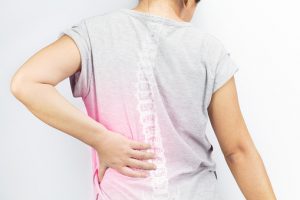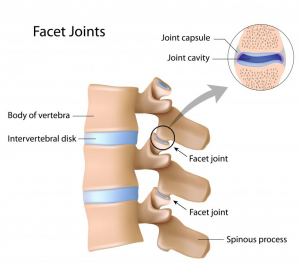
There are 24 vertebrae in the spine, with two facet joints between each segment of vertebrae. Smooth cartilage and a fluid-filled capsule called the synovial protect our facet joints. These help the joint move without friction.
However, it isn’t uncommon for these structures to break down over time. This can lead to mild or moderate facet joint arthritis.
Facet arthropathy is associated with aging, as a common cause is spinal degeneration that occurs with age. It is seen among those aged 40 to 70 years along with those who have a previous spinal or back injury.

Image Credit: unionpt.com
Facet joint anatomy
For many people, a quick review of anatomy provides a better understanding of facet arthropathy.
Facet joints are best described as joints where two or more bones are joined. One pair of facet joints faces upward and one downward. They are on the left and right, are hinge-like, and are located in the back of the spine.
A capsule made of connective tissue and fluid to keep the joint lubricated surrounds each joint. Cartilage allows the joints to glide smoothly against each other.
The facet joints are essentially made up of joint space, hyaline cartilage, synovial membrane, fibrous capsule, nerve fibers, and something called substance P, which is an inflammatory mediator. We have facet joints at every part of our spine besides the top vertebrae that connects our head to our spine.
Types of Facet Arthropathy
Facet arthropathy or facet arthritis is divided into different types depending on the location of the joint. Here’s a look at the facet joint arthropathy categories:
Lumbar
This is degeneration of the lumbar joints, referred to as facet arthropathy of L1-L5, which represents the lumbar vertebrae. This is often due to poor body mechanics.
Cervical Facet Arthropathy
This means the joints of the neck are experiencing degeneration. It might be called C1-C7. Both poor body mechanics and blunt trauma can cause cervical facet arthropathy.
Degenerative Facet Arthropathy
This is another way to describe facet joint arthropathy. It’s often used in a “full depth diagnosis.”
Hypertrophic Facet Arthropathy
Hypertrophy is a term that refers to the increase of an organ or area of the body. In the case of facet arthropathy, it is the section of the facet joint that is abnormal, causing pain near the specific joint.
Bilateral Facet Arthropathy
This means that degeneration is taking place on both sides of the joint.
Thoracic Facet Arthropathy
The joints in the thoracic (upper back or chest) area can deteriorate. This is referred to as degeneration in T1-T2. It causes radiating pain in the arms and chest.
Multilevel Facet Arthropathy
A type of arthropathy that tends to appear later in life and involves multiple facet joints.
Symptoms of Facet Arthropathy
Facet arthropathy symptoms vary slightly depending on the type of degeneration you’re experiencing, but what follows are the primary facet joint arthropathy symptoms recorded by medical experts:
- Mild to severe lower back pain (worse when standing, bending, or twisting)
- Pain confined to a specific area of the spine
- Joint stiffness
- Joint lockage
- Tingling, numbness, and weakness
- Bone spurs (tiny outgrowths that develop in advanced stages)
- Spinal stenosis (narrowing of spaces in the spine) leads to weakness in the buttocks and legs, along with back pain.
- Joint tenderness and loss of muscle flexibility
- More discomfort leaning backward as opposed to forward
- Low back pain that radiates into the buttocks and down the back of the upper leg
- Pain radiating into shoulders, upper back, and chest (cervical joint problems)
Causes of Facet Arthropathy
Facet disease can be a form of osteoarthritis and is often called facet arthrosis. Facet arthropathy causes can be due to many different factors. One of the biggest contributors is the natural aging process. As we get older, there is a gradual loss of water and the slow breakdown of collagen fibers. As some people casually say, “the parts just don’t work like they used to.” Below is a list of other factors that can lead to facet joint syndrome.
- Obesity
- Genetics
- Gender
- Overexertion
- Traumatic injury
- Illness or infection
- Poor posture
- Improper lifting
Often times, the pressure that is due to overloading the facet joints can lead to erosion of the discs in the spine. As these discs degenerate, they wear away, causing disorientation of facet joints. In some cases, cartilage wears away, the fluid that surrounds the facet joints begins to reduce in volume, and friction causes bone spurs. Some spurs press against nerve roots or they force into the spinal canal, forming spinal stenosis. All of this causes pain in the back.
Complications of Facet Arthropathy
Facet arthropathy can lead to bone spurs, which are tiny bone projections or outgrowths. Bone spurs decrease the amount of space available for nerve roots that over time may lead to spinal stenosis.
Spinal stenosis causes numbness, pain, and weakness in the buttocks and legs and is associated with other conditions similar to facet arthropathy like arthritis.
Arthritis is a large contributing factor to the spine or degenerative disc diseases. This can cause back pain and pain elsewhere in the body.
Diagnosis of Facet Arthropathy
Lower back pain is a common complaint, and in some cases, it could be facet arthropathy. If you’re experiencing back pain that just won’t go away, see a doctor to get a proper diagnosis. The following tests can help identify the problem:
CT scan or MRI scan: These imaging tests can indicate facet joint degeneration.
Bone scan: This is also referred to as a bone density test and can show active areas of inflammation in the spine.
X-ray: An x-ray can help a doctor evaluate the overall condition of your spine.
Facet joint block: Anti-inflammatory steroid injections relieve facet joint pain, so if you have an injection and your back pain goes away, chances are you have facet arthropathy.
Fluoroscope: This is an injection of local anesthetic into the affected area. If the pain is relieved, facet arthropathy is usually confirmed.
Treatment for Facet Arthropathy
In terms of facet arthropathy treatment, there are a number of approaches ranging from moderate to aggressive. The treatment will largely depend on the type of arthropathy and the level of pain the person is experiencing. The following list covers off most of the treatment options for facet arthropathy:
Physiotherapy: Some experts consider this the most important treatment option. It can help increase the range of motion in the joints and improve muscle and ligament strength.
Over-the-counter medicine: Acetaminophen or ibuprofen is used to manage pain while people are engaging in physiotherapy or at home exercise.
Tricyclic antidepressants: Studies show that such antidepressants are effective in reducing chronic low back pain for some people.
Pregabalin: Also known as Lyrica and usually prescribed for fibromyalgia, some say it helps with their lower back pain.
Serotonin-norepinephrine reuptake inhibitors: Known to be helpful in treating nerve pain.
Morphine: Used in cases of severe pain
Anesthetic injections: Local anesthetic injected into facet joints every six to nine months.
Radio frequency: An injection used to interrupt pain in joints
Sinu-vertebral nerve ablation: The destruction of nerves using electrical current or surgery.
Surgery: Operations such as spinal fusion
Prevention of Facet Arthropathy
Facet joint syndrome can be painful and make enjoying simple daily activities impossible. If you want to prevent facet arthropathy from occurring, check out our tips below.
- Stay active: Being immobile causes reduced circulation and is linked to increased weight, which puts pressure on the spine.
- Eat healthily: A nutritious diet will help keep the joints lubricated and manage weight.
- Avoid tobacco and alcohol: These can decrease circulation as well as contribute to the drying out of joints.
- Use good posture: Be aware of posture while sitting and standing.
- Apply proper body mechanics: Bend and lift the right way.
- Maintain flexibility: Practice flexibility through various exercises.
- Stretch: Include stretching exercises in your regular workout routine.
- Supplement: Ensure that you are getting enough calcium and vitamin D.
In addition to the tips above, you can do exercises that are specific to strengthening your back. Make sure you get good instructions from a qualified physiotherapist or personal trainer before attempting any back exercises so you don’t injure yourself.
Studies show that there is an 18 percent chance of people between the ages of 31 and 40 experiencing facet joint arthropathy, while 44 percent of those between the ages of 51 and 60 are likely to get the condition. Most doctors agree that the best way to prevent and help with pain caused by facet arthropathy is to live a healthy lifestyle and to practice proper posture.
Prognosis of Facet Arthropathy
Once facet joints become damaged, they cannot be fixed, but patients can still obtain relief from symptoms. Treatments like medications and physical therapy can help ease pain and improve mobility. Ideally, patients should adhere to a healthy lifestyle in order to improve their condition.